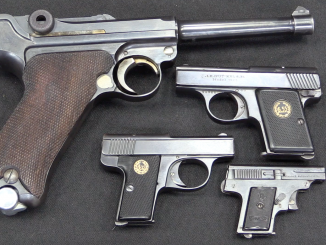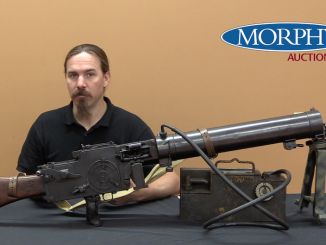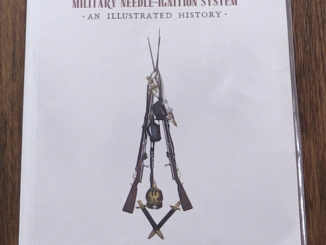Today we are taking a look at H&K’s PDW, the MP7. Specifically, we’re going to go over the changes made form the MP7A1 to the MP7A2 pattern…
Related Articles

Semiauto pistol
Menz Liliput Pocket Pistols: 4.25mm and 6.35mm

Conversion
The MG 08/15 Updated Between the Wars

Bolt Action Rifles

Why are parts of the bolt “blacked” “out” in the video.
The owner asked me not to show the serial number. Some people are concerned about that sort of thing, and I do as the gun owner requests.
Imho this is one of the few weapons that make sense. A real personal defence device.
Since Ian’s video shooting the MP7, I’ve always wondered why he found it jarring to shoot. Chambering a little cartridge (that a blowback could easily handle) in a locked-breech PDW (that is big and heavy by pistol standards) seems like it would be pretty hard to screw up from a recoil standpoint.
It seems clear from this video that the part of the bolt carrier that holds the bolt seems unduly long relative to the cartridge length, and must be beating up the back of the receiver.
The combination of locked breech and fixed barrel means that the initial onset of the recoil impulse will be sharper than it would be in a blowback or recoil-operated design, and I think that’s what Ian was commenting on. It’s probably an exaggeration to say that they “screwed up” the recoil, just that it was noticeably different than expected. We’d need something like a timed and scored course of fire to pin that down. If it feels a bit snappy but shoots fast and accurate, then they didn’t screw up.
Theoretically. In practice, the gas system (especially an extremely short one like this) launches the BCG countermass rearward so quickly that the initial onset is not noticeable, and gas-operated firearms are generally regarded as the softest shooting for a given caliber. Blowback PCCs are not less “snappy” than gas-op pistol caliber ARs, but kick noticeably harder – even compared to gas-op 5.56s with much greater power. Likewise in comparison with CMMG radial-delayed blowbacks, which have fixed barrels and similar opening delays. Imagine shooting a blowback 12 gauge compared to a gentle gas shotgun!
Also, I’m not sure how much you’ve shot calibers in this envelope, but it would require a major screwup to make them “snappy”. I have a .22TCM 1911A2 (same energy from a 5″ barrel as 4.6 from an MP7, and more momentum / power factor, so more recoil if other factors were equal). Recoil-operated, so theoretically advantageous for [onset of] recoil, but it’s such a kitten that no one would ever describe it as “snappy” even in a fixed / manually operated pistol. I can’t imagine how lightly / unnoticeably it would kick if it weighed over 4.5lb (over twice its current weight).
The probable reason for adoption of positively locked, gas operated system is in the high pressure the 4.6x30mm round operates with. They cite 58kSI; that is a HIGH pressure on par with 5.56x45mm shot. How else you would get 700 m/s out of 0.8ccm of cartridge volume?
https://en.wikipedia.org/wiki/HK_4.6%C3%9730mm
If in blowback operated firearm, say with 9mm Para some advance of breech before max. pressure is over is tolerable, in this case it is definitely not. The chamber has to be locked and is opened with some delay due to piston action.
All in all, this is arguably a quirky system which likely will not see lot of response worldwide and already now qualifies as a Forgotten Weapon. But I believe for its creators it was lots of fun to work on.
Was I wrong with that “worldwide response”? Perhaps yes; even Vatican ordered them 🙂 https://en.wikipedia.org/wiki/Heckler_%26_Koch_MP7
My totally subjective guess on why they are not being issued to rear-echelon troops to replace pistols: They are perceived as “too fancy” for those troops.
Also might be too expensive for rear-echelon and related groups of troops. (At a guess)
This is not correct. They are issued to medical personnel, drivers and security police (among others) in the Norwegian armed forces. Granted, we are not talking about a lot of guns, but to say they are not issued to rear echelon troops full stop is incorrect.
I went back and rewatched the video on firing and I noticed in the super slow motion that on the first round the slide release came back. Was this an error on the shooter or was it a flaw in the design.
Great videos, keep up the great work.
Sorry, it was the charging handle, not a slide release
As far as I know the MP7 is issued as a PDW in the classical sense by the Bundeswehr and the Norwegian Norges forsvar at least to a certain degree to, for example, tank crews, drivers, guards, it replaced the Uzi in that role in the Bundeswehr and the MP5 in the Norges forsvar.
It is also fielded as a PDW for helicopter pilots in the French army.
Thanks Ian for blocking the serial number per owners request. It’s a beautiful gun but I too wondered what the fuzziness was about before the aha moment. PS made me think of the Keltec CMR 30 as I was watching this.
Is it a beautiful gun? It’s ungainly and made from plastic. I’m sure it is a well engineered firearm but the squeezy plastic charging handle? Yuck.
Oddly, we agree on something! The charging handle looks like it would eventually wear and start whacking the shooter in the nose every shot. That forward canted pistol grip looks most uncomfortable.